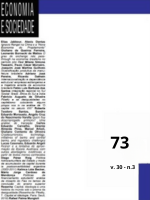Resumo
O objetivo dessas notas é mostrar, que tanto na versão de A. Hansen quanto na de L. Summers, a argumentação sobre o problema da estagnação secular se faz baseada em fundamentos teóricos questionáveis, na medida em que parecem não serem construídos de forma coerente nem com a abordagem neoclássica para a teoria do crescimento, nem com os modelos heterodoxos de crescimento liderado pela demanda. Partimos da crítica, recentemente apresentada por F. Petri, ao uso incoerente da função investimento neoclássica em situações de desemprego persistente. Mostramos que o debate atual se conecta diretamente com o antigo debate sobre os dois problemas de consistência das teorias de crescimento a longo prazo levantados por R. Harrod. A análise nos permitirá entender melhor algumas questões do debate atual, como a polêmica Gordon-Summers sobre se as causas da recente tendência à estagnação nos países avançados deveriam ser atribuídas a fatores de oferta ou de demanda.
Referências
ALLAIN, O. Demographic growth, Harrodian (in)stability and the supermultiplier. Cambridge Journal of Economics, Feb. 2018.
CESARATTO, S.; SERRANO, F.; STIRATI, A. Technical change, effective demand and employment. Review of Political Economy, v. 15, n. 1, p. 33-52, 2003.
DELEIDE, M.; MAZZUCATO, M. Putting austerity to bed: technical progress, aggregate demand and the supermultiplier. UCL Institute for Innovation and Public Purpose, 2018. (Working Paper Series, 2018-01).
FAZZARI, S.; FERRI, P.; VARIATO, A. Demand-led growth and accommodating supply. 2017. (Working Paper). Available at: http://pages.wustl.edu/fazz/papers
GIRARDI, D.; PATERNESI MELONI, W.; STIRATI, A. Persistent effects of autonomous demand expansions. Institute for New Economic Thinking, Feb. 2018. (Working Paper, n. 70).
GAREGNANI, P. Notes on consumption, investment and effective demand. Cambridge Journal of Economics, v. 2, p. 335-353; v. 3, p. 63-82, 1978-79. Reprinted in: Eatwell e Milgate (1983).
GORDON, R. Secular stagnation: a supply-side view. The American Economic Review, v. 105, n. 5, p. 54-59, 2015.
HARROD, R. An essay in dynamic theory. The Economic Journal, v. 49, n. 193, p. 14-33, 1939.
HARROD, R. Towards a dynamic economics. London: Macmillan, 1948.
HANSEN, A. H. Economic progress and declining population growth. The American Economic Review , v. 29, n. 1, p. 1-15, 1939.
LAVOIE, M. Post Keynesian economics: new foundations. Edward Elgar, 2014.
NAH, W.; LAVOIE, M. Convergence in a neo-Kaleckian model with endogenous technical progress and autonomous demand growth. 2017. Disponivel em: https://www.boeckler.de/pdf/v_2017_11_11_lavoie.pdf
PETRI, F. The inevitable dependence of investment on expected demand: implications for neoclassical macroeconomics. In: LEVRERO, S. (Org.). Sraffa and the reconstruction of economic theory. 2013. v. 2, p. 44-67.
PETRI, F. Neglected implications of neoclassical capital-labour substitution for investment theory: another criticism of Say’s law. Review of Political Economy , v. 27, n. 3, 2015.
SERRANO, F.; FREITAS, F. The Sraffian supermultiplier as an alternative closure for heterodox growth theory. European Journal of Economics and Economic Policy: Intervention, v. 14, n. 1, p. 70-91, 2017. DOI: 10.4337/ejeep.2017.01.06.
SERRANO, F.; FREITAS, F.; BHERING, G. The trouble with Harrod: the fundamental instability of the warranted rate in the light of the Sraffian supermultiplier. Metroeconomica, v. 70, n. 2, p. 263-287, 2019. DOI: 10.1111/meca.12230.
SERRANO, F.; FREITAS, F.; BHERING, G. O supermultiplicador sraffiano, a instabilidade fundamental de Harrod e o dilema de “Oxbridge”. Análise Econômica, v. 38, n. 77, 2019. DOI: /10.22456/2176-5456.7828.
SOLOW, R. A contribution to the theory of economic growth. The Quarterly Journal of Economics, v. 70, n. 1, p. 65-94, Feb. 1956.
SUMMERS, L. Reflections on the ‘new secular stagnation hypothesis’. Secular stagnation: facts, causes and cures. VOXEU-CEPR, 2014. p. 27-38.
SUMMERS, L. Demand side secular stagnation. The American Economic Review , v. 105, n. 5, p. 60-65, 2015.

Este trabalho está licenciado sob uma licença Creative Commons Attribution 4.0 International License.
Copyright (c) 2021 Vivian Garrido Moreira, Franklin Serrano


